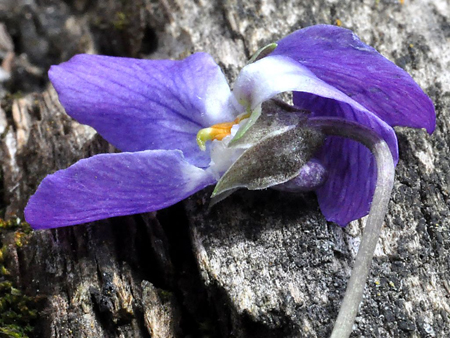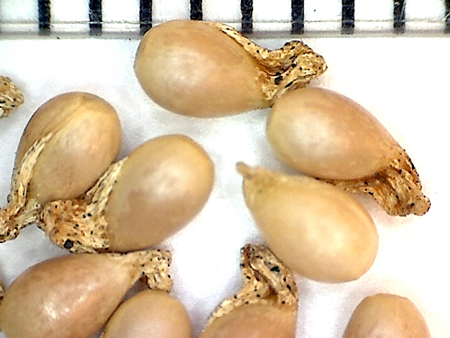Viola odorata L.
Common names:
English Violet, Sweet Violet
Synonyms (incomplete):
Viola odorata L., Sp. pl., ed. 1, 2: 934. 1753
Viola thomsonae Chapm., Fl. South. U.S., ed. 3: 34. 1897 ["1896"]
Description:
Acaulescent stoloniferous mat-forming perennials from somewhat slender to thick brown horizontal rhizome, stolons surficial, produced year-round, greenish, leafless, non-reproductive, terminating in a plantlet, ≤ 15 cm tall; foliage and peduncles green, foliage puberulent to hirtellous, peduncles glabrous or hirtellous; stipules free, glandular-fimbriate; leaves spreading, leaf blades undivided, largest ≤ 45 × 44 mm, orbicular to broadly ovate-deltate (rarely narrowly ovate or reniform), base deeply cordate at base, margins regularly crenate, ciliate, apex broadly rounded or obtuse; chasmogamous peduncle among or above the leaves; chasmogamous flower ≤ 19 mm; calyx glabrous, commonly ciliate; lowest sepals broadly oblong or ovate-lanceolate to narrowly ovate, obtuse with a small callus at tip; auricles short and entire, not elongating in fruit; corolla white or blue (rarely pink or rose), throat white, rarely "double-flowered"; spur weakly to moderately developed, slender or thick, 5–7, white or blue; lateral petals glabrous or bearded with narrowly linear or slightly clavate hairs, spurred petal glabrous; chasmogamous capsule green; cleistogamous flowers produced after chasmogamous, on prostrate peduncle much shorter than petioles and arching upward just before capsule dehiscence; cleistogamous capsule 4.5–6.5 mm, green drying tan with purple spots or blotches, puberulent or hirtellous; seeds (2.7)3.0–4.0 × 1.7–2.0 mm, ivory or tan to light orange-brown, unspotted; 2n=20.
Similar species:
Although this introduced and sometimes cultivated species has often been misidentified as several different species due to lax observation, its mat-forming habit with rosettes connected by green cordlike stolons, densely puberulent to hirtellous foliage, and orbicular to ovate-deltate leaf blades with closely and regularly crenate margins and broadly obtuse to broadly rounded apex should distinguish it at any time of the growing season. Vaguely similar acaulescent non-stoloniferous violets include V. communis, V. domestica, V. latiuscula, V. sororia sensu stricto, V. sororia [glabrous variant] and V. sororia [hirsutuloides variant]. In chasmogamous flower it differs from all of the above in its somewhat elongate spur, and the style terminating in a prolonged downward-pointing "hook" and it also can be distinguished from the mat-forming V. appalachiensis and V. walteri by its membranous or semi-herbaceous glandular-fimbriate stipules, and long hooked style. In cleistogamous fruit it is immediately different from all of the above species in its puberulent or hirtellous capsule and rather large unspotted ivory to light orange-brown seeds.
Ecology:
Lawns, cemeteries, urban woodlots, and roadsides.
Distribution:
European, frequently escaped from cultivation in the Northeast and Great Lakes regions, northern Rockies and western coastal states but rare elsewhere.
Rarity:
None.
Phenology:
Chasmogamous flower March–May, chasmogamous fruit May–June, cleistogamous fruit May–July.
Affinities:
This species belongs to sect. Viola, subsect. Viola.
Hybrids:
None.
Comments:
Brainerd (1921b) and Brainerd Baird (1942) because they excluded all non-native species, and Strausbaugh and Core (1978) did not mention it presumably because it did not occur in West Virginia at that time. Fernald (1950), Henry (1953a), Alexander (1963), Russell (1965), Scoggan (1978), Swink and Wilhelm (1979), Gleason and Cronquist (1991), Haines et al. (1991), Ballard (1995, 2000), Voss and Reznicek (2012), Weakley et al. (2012), and Little and McKinney (2015) included it. The puberulent foliage, stout green cordlike vegetative stolons, somewhat exserted orange stamens, downward-hooked style, hirtellous spotted or blotched cleistogamous capsule, and large pale seeds easily distinguish this from native species. It is often misidentified as V. sororia, and it is surely more widely distributed than range maps indicate. Populations often have both purple and white floral morphs; the purple form tends to have lateral petals densely bearded within, while the white form typically lacks beards.
Literature Cited:
Alexander, E. J. 1963. Violaceae. In Gleason, H. A., The new Britton and Brown illustrated flora of the northeastern United States and adjacent Canada. Hafner Publishing Co., Inc., New York, NY. 552-567.
Ballard Jr., H. E. 1995 ["1994"]. Violets of Michigan. Michigan Botanist 33: 131-199.
Ballard Jr., H. E. 2000. Violaceae. In Rhoads, A. (ed.). Flora of Pennsylvania. University of Pennsylvania Press, Philadelphia, PA. 700-710.
Brainerd, E. 1921b. Violets of North America. Vermont Agricultural Experiment Station Bulletin 224: 1-172.
Brainerd Baird, V. 1942. Wild violets of North America. University of California Press, Berkeley, CA.
Fernald, M. L. 1950. Violaceae. In Gray’s Manual of Botany, 8th ed. American Book Company, New York, NY. 1022-1042.
Gleason, H. A., and A. Cronquist. 1991. Violaceae. In Manual of vascular plants of northeastern United States and adjacent Canada, 2nd ed. New York Botanical Garden, Bronx, NY. 157-163.
Haines, A., E. Farnsworth, and G. Morrison. 2011. Violaceae. In Flora Novae Angliae. Yale University Press, New Haven, CT. 873-886.
Henry, L. K. 1953a. The Violaceae in western Pennsylvania. Castanea 18(2): 37-59.
Little, R. J., and L. E. McKinney. 2015. Violaceae. In Flora of North America: Cucurbitaceae to Droseraceae, 106. Oxford University Press, New York, NY.
Russell, N. H. 1965. Violets (Viola) of the central and eastern United States: An introductory survey. Sida 2: 1-113.
Scoggan, H. J. 1978. Violaceae. In Flora of Canada, Part 3–Dicotyledoneae (Saururaceae to Violaceae). National Museums of Canada. Ottawa, Canada. 1103-1115.
Swink, F., and G. Wilhelm. 1979. Violaceae. In Plants of the Chicago region, 2nd ed. revised and expanded. Morton Arboretum, Lisle, IL. 384, 801-810.
Voss, E. G., and A. A. Reznicek. 2012. Violaceae. In Field manual of Michigan flora. The University of Michigan Press, Ann Arbor, MI. 913-922.
Weakley, A. S., J. C. Ludwig, and J. F. Townsend. 2012. Violaceae. In Flora of Virginia. BRIT Press, Fort Worth, TX. 963-975.

Rhizome by Robert L. Carr, "Flora of Eastern Washington and Adjacent Idaho" website (web.ewu.edu/ewflora/)

Chasmogamous flowering habit of white and purple flower morphs by Jean Baxter, "Go Botany" website, Native Plant Trust

Chasmogamous flowering habit by Paul Busselen, Biology Department, Katholieke Universiteit Leuven, Campus Kortrijk

Leaves by Keir Morse, "Go Botany" website, Native Plant Trust

Chasmogamous flower profile view by Tony Frates, SERNEC portal

Seeds from herbarium specimen: OH, 6 Jul 1936, F. O. Grover s.n. (OS367834)

Map by the Biota of North America Program